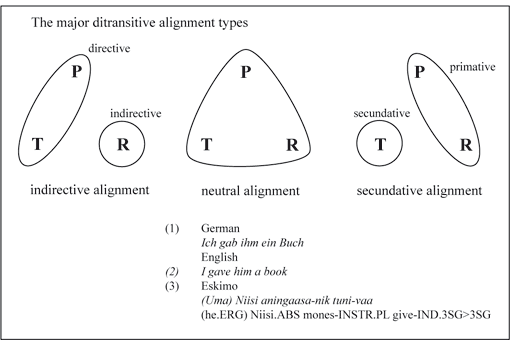Project Members
- Andrej Malchukov
- Bernard Comrie
- Martin Haspelmath
- Birgit Jänen
Ditransitive constructions in the world's languages

In this project, we studied the grammatical properties of ditransitive constructions (i.e. constructions with an agent, a recipient, and a theme argument) in a broadly comparative perspective. We compiled a database with relevant information on about 200 languages, and we planned to publish this database as well as a monograph that presents the results of our inquiries.
The project addressed cross-linguistic variation in ditransitive constructions, i.e. constructions with an agent, theme (T) and recipient (R) arguments. These typically include canonical ditransitives verbs (such as 'give', 'sell', or 'show'), but may also extend to other verb classes in individual languages. The research topics included the basic properties of ditransitive constructions in terms of their coding (through flagging/case or indexing/agreement), as well as syntactic and lexical properties. As is well-known, languages differ in ditransitive ‘alignment’, that is which of the object arguments – T or R - is coded like monotransitive patient (P) (see the schematic representation of the indirective (T=P), neutral (T=P=R) and secundative (P=R) alignments, and the corresponding examples from German, English and Eskimo, respectively). Apart from providing a comprehensive overview of basic alignment patterns of ditransitive constructions in individual languages, the project addressed morpho-syntactic properties of the object arguments, using a number of syntactic diagnostics (e.g., passivization), to detect alignment in the syntactic domain. Further morphological issues included peculiarities of derived ditransitive constructions (applicatives, causatives), as compared to basic ditransitives, as well as less studied phenomena such as suppletion in the paradigm of ditransitive verbs. Finally, the extensions of ditransitive constructions across different verb classes were studied, which was of particular interest given that languages range from those having an open class of ditransitives to those having a closed class. The data were collected from the secondary sources as well as through elicitation on the basis of a questionnaire. The results of the analysis were summarized in a monograph as well as in the form of a database which will eventually be published on-line.
This project is a member of the DFG-funded Forschergruppe "Grammatik und Verarbeitung verbaler Argumente".
Publications
Comrie, Bernard. 2003. Recipient person suppletion in the verb "give". In: Wise, Mary Ruth and Headland, Thomas N. and Brend, Ruth M. (eds.) Language and Life: Essays in Memory of Kenneth L. Pike. Dallas: SIL International and the University of Texas at Arlington, 265-281
Haspelmath, Martin. 2007. "Ditransitive alignment splits and inverse alignment". Functions of Language 14.1:79-102.
Malchukov, Andrej. 2007. "Animacy and asymmetries in differential case marking." Forthcoming in Lingua (special issue on Animacy edited by M. Lamers and P. de Swart).